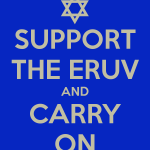Introduction to the Laws of Eiruvin Series

 In my Current Jewish Questions series we recently completed a three part sub-unit covering a basic introduction to the laws of eiruvin. For those interested in a general overview of the laws of eiruvin, I am collecting the links in this convenient post. Note that since this is an introductory class it does not cover many of the technicalities which affect the practical validity of any communal eiruv. In other words, do not confuse listening to this series as semikhah with which you can now pasken eiruvin for your (or anyone’s) community.
In my Current Jewish Questions series we recently completed a three part sub-unit covering a basic introduction to the laws of eiruvin. For those interested in a general overview of the laws of eiruvin, I am collecting the links in this convenient post. Note that since this is an introductory class it does not cover many of the technicalities which affect the practical validity of any communal eiruv. In other words, do not confuse listening to this series as semikhah with which you can now pasken eiruvin for your (or anyone’s) community.
Part 1 – General Overview: Discusses the innovation of the eruv, its origins and the basics of what it accomplishes.
Part 2 – Physical Corrections: Covers the tikkunim or physical corrections one must make to an area as a prerequisite for establishing an eiruv.
Part 3 – Coming Together: Explains the requirement for 100% communal participation, as well as several solutions when that proves impossible.
